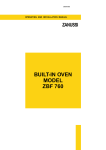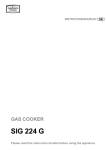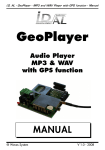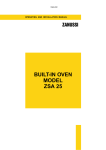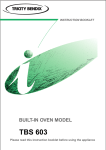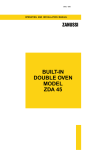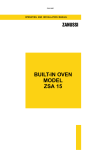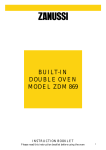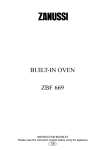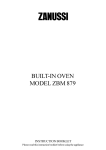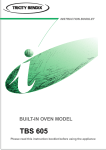Download Zanussi ZBC 748 User's Manual
Transcript
35668-6701 OPERATING AND INSTALLATION MANUAL ZANUSSI BUILT-IN OVEN MODEL ZBC 748 2 Important Safety Information These warnings are provided in the interest of safety. You MUST read them carefully before installing or using the appliance. Your safety is of paramount importance. If you are unsure about any of the meanings of these WARNINGS, contact the Customer Care Department Installation • The oven must be installed according to the instructions supplied. Any electrical work must be undertaken by a qualified electrician/competent person. • This oven is heavy and care must be taken when moving it. Do not try to move the appliance by pulling the door handle. • Remove all packaging, both inside and outside the oven, before using the appliance. After installation, please dispose of the packaging with due regard to safety and the environment. • It is dangerous to alter the specifications or modify the appliance in any way. During Use • This oven has been designed for cooking edible foodstuffs only and must not be used for any other purposes. • Never line any part of the oven with aluminium foil. Do not allow heatproof cooking material, e.g. roasting bags, to come into contact with oven elements. • Never place plastic or any other material which may melt in or on the oven. • Do not place sealed cans or aerosols inside the oven. They may explode if they are heated. • Do not hang towels, dishcloths or clothes from the oven or its handle. They are a safety hazard. • Do not use this oven if it is in contact with water and never operate it with wet hands. • Always cook with the oven door closed. • Use any oven proof cookware which will withstand temperatures of 250°C. • Take great care when heating fats and oils as they will ignite if they become too hot. • Always use oven gloves to remove and replace food in the oven. Similarly always use oven gloves to remove and replace the grill pan handle, before and after grilling. • Always remove the grill pan handle when grilling. • Ensure that you support the grill pan when removing it from the oven. • Take care to follow the recommendations given for tending the food when grilling. • Always stand back from the oven when opening the oven door, to allow any build-up of steam or heat to release. • Stand clear when opening the drop down oven door. Do not allow it to fall open - support the door using the door handle, until it is fully open. • Ensure that the anti-tip oven shelves are installed in the correct way (see instructions). • Ensure that all control knobs are in the OFF position when not in use. • Do not leave cookware containing foodstuffs, e.g. fat or oil in or on the oven in case it is inadvertently switched ON. • When using other electrical appliances, ensure the cable does not come into contact with the hot surfaces of the cooking appliance. Child Safety • This appliance is designed to be operated by adults and children under supervision. Young children must not be allowed to tamper with the controls or play near or with the appliance. • Accessible parts, especially around the grill area, become hot when the cooker is in use. Children should be kept away until it has cooled. Maintenance and Cleaning • Only clean this oven in accordance with the instructions. • The oven should be kept clean at all times. A build-up of fats or other foodstuffs could result in a fire, especially in the grill pan. • Always allow the cooling fan to cool the oven down before switching off at the electrical supply prior to carrying out any cleaning or maintenance work. Service • You must not attempt to repair the appliance yourself. Repairs carried out by inexperienced persons may cause injury or serious malfunctioning. Refer to your local Zanussi Service Force Centre. Always insist on genuine Zanussi spare parts. Disposal of an old appliance • Make the appliance unusable, by cutting off the cable, and remove any door catches, to prevent small children being trapped inside It is most important that this instruction book should be retained with the appliance for future reference. Should the appliance be sold or transferred, always ensure that the book is left with the appliance in order that the new owner can get to know the functions of the appliance and the relevant warnings. 3 Contents For the User For the Installer Important safety information Technical Data Page 24 Page 3 Electrical Connection Page 24 Description of the appliance Page 5 Installation Page 25 Controls Page 6 Before the First Use Page 7 Using the Conventional Oven Page 8 Cooking Chart Page 10 Using the Fan Oven Page 11 Defrosting Page 14 Grilling Page 15 Cleaning the Oven Page 18 Care of Catalytic Liners Page 20 Cleaning the Hinged Grill Page 21 What happens if something goes wrong Page 22 Service and Spare Parts Page 23 Peace of Mind for 24 months Page 23 Guide to Use the instructions The following symbols will be found in the text to guide you throughout the Instructions: Safety Instructions ☞ i Step by step instructions for an operation Hints and Tips Enviromental information 4 Oven Door Protection Device All our appliances comply with the European safety standards. Nevetheless, in order to ensure the highest safety level, and avoid little children to be exposed to the heat when the appliance is operated, it is possible to fit a special ptotection device to the oven door. This device can be purchased in our Service Force Centres, specifying the relevant code (35791) and the Product No. shown on the rating plate. Fitting instructions are provided within the kit package. This appliance complies with the following E.E.C. Directives: * 73/23 - 90/683 (Low VoltageDirective); * 93/68 (General Directives); * 89/336 (Electromagnetical Compatibility Directive) . and subsequent modifications MANUFACTURER: ELECTROLUX ZANUSSI ELETTRODOMESTICI S.p.A. Viale Bologna 298 47100 FORLÌ (Italy) Description of the Appliance Thermostat Control Knob Clock 11 12 Oven Function Control Knob 1 2 10 9 3 4 8 7 6 5 Grill Element Oven Light Fan Grease Filter Rating Plate Grill trivet Grill/roasting pan Removable handles 5 Controls Oven Function Control Knob Oven Light - The oven light will be on without any cooking function 0 Defrost Setting - This setting is intended to assist in thawing of frozen food (see page 14). Conventional cooking - The heat comes from both the top and bottom element, ensuring even heating inside the oven. Top heating element - The heat comes only from the top of the oven. Bottom heating element - The heat comes only from the bottom of the oven. Fan ducted cooking - This allows you to roast or roast and bake simoultaneously using any shelf, without flavour transference. Inner grill element - The heat comes from the grill element at the top of the oven. Double Grill - This setting enables you to get the maximum power from the grill element. Thermal Grill - This function offers an alternathive method of cooking food items. The grill element and the oven fan operate together, circulating hot air around the food. Thermostat Control Knob 50 0 MAX 100 Turn the thermostat control knob clockwise to select temperatures between 50°C and 250°C (MAX). 20 0 150 6 The Oven Clock 11 Turn the dial marked by the arrow clockwise to set the time of day. 12 1 2 10 9 3 4 8 7 6 5 Before the First Use Remove all packaging, both inside and outside the oven, before using the appliance. Before first use, the oven should be heated without food. During this time, an unpleasant odour may be emitted. This is quite normal. ☞ 1. Switch the oven function control knob to conventional cooking . 2. Set the thermostat control knob to MAX. 3. Open a window for ventilation. 4. Allow the oven to run empty for approximately 45 minutes. This procedure should be repeated with the grill function for approximately 5-10 minutes. 7 Using the Conventional Oven When using this setting, heat comes from both the top and bottom elements. This allows you to cook in a single level and is particularly suitable for dishes which require extra base browning such as pizzas, quiches and flans. Gratins, lasagnes and hotpots which require extra top browning also cook well in the conventional oven. This form of cooking gives you the opportunity to cook without the fan in operation. The oven has fourteen shelf levels, and is supplied with two shelves. It is important that these shelves are correctly positioned as shown in the diagram. ☞ How to Use the Conventional Oven 1. Turn the oven function control knob to . 2. Turn the thermostat control to the required temperature. THINGS TO NOTE ● The oven light will come on when the oven function control knob is set. ● The thermostat control light will remain on until the correct temperature is reached. It will then cycle on and off to show how the temperature is being maintained. Top oven element only This function is suitable for finishing cooked dishes, eg; lasagne, shepherds pie, cauliflower cheese etc. Bottom oven element only This function is particularly useful when blind-baking pastry or cooking pizza. Condensation and steam When food is heated it produces steam in the same way as a boiling kettle. The oven is vented to allow some of this steam to escape. However, always stand back from the cooker when opening the oven door to allow any build up of steam or heat to release. If the steam comes into contact with a cool surface on the outside of the oven, e.g. a trim, it will condense and produce water droplets. This is quite normal and is not caused by a fault on the oven. To prevent discolouration, regularly wipe away condensation and also soilage from surfaces. 8 The cooling fan During cooking the cooling fan will cycle ON and OFF. This is quite normal. It may run on after the oven is switched off to keep the controls cool. NOTE The action of the cooling fan will depend on how long the oven has been used and at what temperature. It may not switch in at all at lower temperature settings nor run on where the oven has only been used for a short time. i Hints and Tips The middle shelf position allows for the best heat distribution. To increase base browning simply lower the shelf position. To increase top browning, raise the shelf position. The material and finish of the baking trays and dishes used will affect base browning. Enamelware, dark, heavy or non-stick utensils increase base browning, while oven glassware, shiny aluminium or polished steel trays reflect the heat away and give less base browning. Always place dishes centrally on the shelf to ensure even browning. Stand dishes on suitably sized baking trays to prevent spillage onto the base of the oven and make cleaning easier. Do not place dishes, tins or baking trays directly on the oven base as it becomes very hot and damage will occur. For faster preheating use the fan oven function to preheat the oven until the oven indicator neon goes out, then swich the selector to the conventional oven setting. Single level cooking gives best results. If you require more than one level cooking use the fan oven function. 9 Cooking Chart - Conventional Oven Temperature (°C) Runner Positions Cooking Time (mins) Biscuits 170-200 2/3 25-30 Bread, buns, yeast, doughs 200-230 2 35-45 Casseroles 140-170 2 90-180 Cakes - small, Queen Victoria sponge 170-190 2/3 18-25 Cakes - madeira, rich fruit 130-180 2 90-150 Choux pastry, eclairs 200-230 2 30-35 Fish 200-230 2/3 20-40 Fruit pies, plate tarts, crumbles 180-210 2 50-65 Meringues 90-100 2 90-150 Milk puddings 140-160 2 90-150 Pate, terrine (in baine-marie) 160-180 1 60-90 Pizzas 200-230 2 25-30 Puff pastry, sausage rolls, vol-au-vents 230-260 2 15-25 Quiches, flans 170-200 2 50-60 Scones 230-250 2/3 8-12 Souffle 200-230 2 35-45 Stuffed vegetables 230-250 2 Food Roast meat & poultry 160-180 2 Yorkshire pudding 200-230 2 Keep food warm, heat dishes 90-100 2 35-45 see meat + poultry roasting chart Meat and Poultry Roasting Chart Meat Temperature (°C) Beef 180-200 20-35 mins per 1/2kg (lb) + 20-35 mins Beef, boned 180-200 25-35 mins per 1/2kg (lb) + 25-35 mins Mutton and Lamb 180-200 25-35 mins per 1/2kg (lb) + 25-35 mins Pork and Veal 180-200 30-40 mins per 1/2kg (lb) + 30-40 mins Ham 180-200 30-40 mins per 1/2kg (lb) + 30-40 mins Chicken 180-200 15-20 mins per 1/2kg (lb) + 20 mins Turkey and Goose 180-200 15-20 mins per 1/2kg (lb) up to 3.5kg (7lb) Cooking Time + 15 mins per 1/2kg Duck 10 180-200 25-35 mins per 1/2kg (lb) + 20 mins 40-50 Using the Fan Oven The air inside the oven is heated by the element around the fan situated behind the back panel. The fan circulates hot air to maintain an even temperature inside the oven. The advantages of cooking with this function are: ✓ Faster Preheating As the fan oven quickly reaches temperature, it is not usually necessary to preheat the oven although you may find that you need to allow an extra 5-7 minutes on cooking times. For recipes which require higher temperatures, best results are achieved if the oven is preheated first, e.g. bread, pastries, scones, souffles, etc. ✓ Lower Temperatures Fan oven cooking generally requires lower temperatures than conventional cooking. Follow the temperatures recommended in the chart at page. 11 or remember to reduce temperatures by about 20-25°C for your own recipes which use conventional cooking. ✓ Even Heating for Baking The fan oven has uniform heating on all runner positions. This means that batches of the same food can be cooked in the oven at the same time. However, the top shelf may brown slightly quicker that the lower one. This is quite usual. There is no mixing of flavours between dishes. FO 2079 ☞ How to Use the Fan Oven 1. Turn the oven function control knob to . 2. Turn the thermostat control to the required temperature. THINGS TO NOTE During cooking, the cooling fan and the thermostat control light will operate in the same way as described for the conventional oven function. 11 Cooking Chart - Fan Oven This chart is intended as a guide only. It may be necessary to increase or decrease the temperature to suit your individual requirements. Only experience will enable you to determine the correct setting for your personal requirements. Food Shelf Position Biscuits Bread Casseroles Cakes: Small and queen Sponges Madeira Rich Fruit Christmas Meringues Fish Fruit Pies and Crumbles Milk Puddings Pastry: Choux Shortcrust Flaky Puff Plate Tarts Quiches/Flans Scones Roasting: Meat & Poultry } Shelf positions are not critical but ensure that oven shelves are evenly spaced when more than one is used. Cooking Temp (°C) 180-190 210-220 130-140 160-170 160-170 140-150 130-140 130-140 90-100 170-190 190-200 130-140 190-200 180 170-180 210-220 160-180 When roasting, ensure the meat is cooked thoroughly, use a meat thermometer if preferred to check the centre temperature has reached the required temperature (see table below). MEAT TEMPERATURES Beef Rare - 60°C Medium - 70°C Well Done - 80°C Pork Well Done - 80°C Lamb Medium - 70°C Well Done - 80°C Cookware Baking trays, oven dishes, etc. should not be placed directly against the grid covering the fan at the back of the oven, or placed on the oven base. Do not use baking trays larger than 30 cm x 35 cm (12 in x 14 in) as they will restrict the circulation of heat and may affect performance. 12 The effects of dishes on cooking results Dishes and tins vary in their thickness, conductivity, colour, etc. which affects the way they transmit heat to the food inside them: A Aluminium, earthenware, oven glassware and bright shiny utensils reduce cooking and underneath browning. B Enamelled cast iron, anodized aluminium, aluminium with non-stick interior and coloured exterior and dark, heavy utensils increase cooking and underneath browning. i Hints and Tips Runner positions are not critical, but make sure the shelves are evenly spread. When cooking more than one dish in the fan oven, place dishes centrally on the shelves rather than several dishes on one shelf. When the oven is full, you may need to allow slightly longer cooking time. A shelf may be placed on the floor of the oven. Place dishes on a shelf in this position rather than on the oven base, to allow air circulation around the food. When the oven is full of the same food, e.g. equal trays of small cakes or equal size victoria sandwich cakes, then they will be cooked in the same time and removed from the oven together. When different sizes of trays or types of food, e.g. biscuits and cakes are cooked, they will not necessarily be ready together. The fan oven can be used to heat foods through without thawing first, e.g. fruit tarts, mince pies, sausage rolls, and other small pastry items. Use a temperature of 190-200°C and allow 20-40 minutes (depending on the quantity of food in the oven). The use of too high temperatures can cause uneven browning. Check with the recommendations for oven temperatures given in the cooking charts, but be prepared to adjust the temperature by 10°C if necessary. Remember to reduce temperatures by about 20-25°C for your own conventional recipes. When roasting do use the trivet in the meat tin. Fat and meat juices will drain into the meat tin below and can be used to make gravy. The trivet also prevents splashes of fat from soiling the oven interior. The meat tin should not be placed on a heated hotplate as this may cause the enamel to crack. 13 Defrosting i Hints and Tips The oven fan operates without heat and circulates the air, at room temperature, inside the oven. This increases the speed of defrosting. However, please note that the temperature of the kitchen will influence the speed of defrosting. This function is particularly suitable for delicate food which could be damaged by heat, e.g. cream filled gateaux, iced cakes, pastries, bread and other yeast products. • Cover food with a lid, aluminium foil or plastic film to prevent drying out during defrosting. • ALWAYS COOK THOROUGHLY IMMEDIATELY AFTER THAWING. • Frozen food should be placed in a single layer when ever possible and turned over half way through the defrosting process. • Only joints of meat and poultry up to 2 kg. (4 lb.) are suitable for defrosting in this way. ☞ How to Use Defrosting 1. Turn the oven function control knob to . 2. Ensure the thermostat control knob is in the OFF position. Refer to the following table for approximate defrosting times. Defrosting time (Mins) Standing time (Mins) Chicken 1000 g. 100-140 20-30 Place chicken on inverted saucer on large plate. Defrost open and turn at half time or defrost covered with foil. Remove giblets as soon as possible. Meat 1000 g. 100-140 20-30 Defrost open and turn at half time or cover with foil Meat 500 g. 90-120 20-30 As above Trout 150 g. 23-35 10-15 Defrost open Strawberries 300 g. 30-40 10-20 Defrost open Butter 250 g. 30-40 10-15 Defrost open Cream 2 x 200 g. 80-100 10-15 Defrost open (cream is easy to whip even if parts of it are still slightly frozen) 60 60 Food Cake 1400 g. Notes Defrost open The times quoted in the chart should be used as a guide only, as the speed of defrosting will depend on the kitchen temperature. For example, the colder the ambient temperature, the longer the defrosting time. 14 Grilling Grilling must be carried out with the oven door closed. The grill pan handles must be removed from the pan. ☞ How to Use the Grill 1. Turn the oven control function knob on . 2. Turn the thermostat control knob on the required temperature. 3. Adjust the grid and grill pan runner position to allow for different thicknesses of food. Position the food close to the element for faster cooking and further away for more gentle cooking. Preheat the grill on a full setting for a few minutes before sealing steaks or toasting. Adjust the heat setting and the shelf as necessary, during cooking During cooking, the cooling fan and the thermostat control light will operate in the same way as described for the fan oven function. i Hints and Tips - Most foods should be placed on the grid in the grill pan to allow maximum circulation of air to lift the food out of the fats and juices. Food such as fish, liver and kidneys may be placed directly on the grill pan, if preferred - Food should be thoroughly dried before grilling to minimise splashing. Brush lean meats and fish lightly with a little oil or melted butter to keep them moist during cooking - Accompaniments such as tomatoes and mushrooms may be placed underneath the grid when grilling meats - When toasting bread, we suggest that the top runner position is used with the grid in its 'high' position OI L - The food should be turned over during cooking, as required. The grill element is controlled by the thermostat. During cooking, the grill cycles on and off to prevent overheating. 15 ☞ How to Use the Inner Grill Element The inner grill provides quick direct heat to the central area of the grill pan. By using the inner grill element for cooking small quantities, it can help to save energy. 1. Turn the oven control function knob on . 2. Turn the thermostat control knob on the required temperature. 3. Adjust the grid and grill pan runner position to allow for different thicknesses of food an follow the instructions for grilling. ☞ How to Use the Thermal Grill Thermal grill offers an alternative method of cooking food items normally associated with conventional grilling. The grill element and the oven fan operate alternately, circulating hot air around the food. The need to check and turn the food is reduced. Thermal grill helps to minimize cooking smells in the kitchen. With the exception of toast and rare steaks, you can thermally grill all the foods you would normally cook under a conventional grill. Cooking is more gentle, therefore food generally takes a little longer to cook with thermal grilling compared with conventional grilling. One of the advantages is that larger loads can be cooked at the same time. 1. Turn the oven control function knob on . 2. Turn the thermostat control knob on the required temperature. Select a maximum temperature of 200°C. 3. Adjust the grid and grill pan runner position to allow for different thicknesses of food an follow the instructions for grilling. 16 i Hints and Tips Prepare foods in the same way as for conventional grilling. Brush lean meats and fish lightly with o little oil or butter to keep them moist during cooking. If thermally grilling on more than one level, it may be necessary to interchange the food on the shelves during cooking. A general guide to cooking times is given below but these times may vary slightly depending on the thickness and quantity of food being cooked. Cooking Chart - Grilling FOOD Grill and Inner Grill Element Thermal Grill Temp (°C) Time (Mins per side) Temp (°C) Time (Mins) Bacon Rashers Beefburgers 200 210 6-10 2-3 190 200 10-15 8-12 Chicken Joints 170 10-15 160 35-45 Chops - Lamb - Pork 180 180 7-10 10-15 170 170 20-25 25-35 Fish - Whole Trout/Herring 170 8-12 170 10-20 - Fillets Plaice/Cod 170 180 4-6 10-15 170 170 10-20 20-30 Kidneys - Lamb/Pig 170 4-6 180 10-15 Liver Sausages - Lamb/Pig 170 180 5-10 10-15 180 190 20-30 10-15 250 1-2 -- - - 170 20-30 depending on size depending on size Kebabs Toast Heating through and Browning, e.g. au-gratin, lasagne, shepherd's pie. Browning dishes only 230 3-5 -- 17 Cleaning the Oven Before cleaning always allow the cooling fan to cool the cooker down before switching off at the electricity supply. The oven should be kept clean at all times. A build-up of fats or other foodstuffs could result in a fire, especially in the grill pan. Cleaning materials Before using any cleaning materials on your oven, check that they are suitable and that their use is recommended by the manufacturer. Cleaners that contain bleach should NOT be used as they may dull the surface finishes. Harsh abrasives should also be avoided. External cleaning Regularly wipe over the control panel, oven door and door seal using a soft cloth well wrung out in warm water to which a little liquid detergent has been added. To prevent damaging or weakening the door glass panels avoid the use of the following: • Household detergent and bleaches • Impegnated pads unsuitable for nonstick saucepans • Brillo/Ajax pads or steel wool pads • Chemical oven pads or aerosols • Rust removers • Bath/Sink stain removers Clean the outer and inner door glass using hot soapy water. Should the ineer door glass become heavily soiled it is recommended that a cleaning such as Hob Brite is used. If the door glass panel becomes chipped or has deep scratches, the glass will be weakened and must be replaced to prevent the possibility of the panel shattering. Contact your local Service Centre who will be pleased to advise further. 18 Oven Cavity The enamelled back panel and the base of the oven cavity are best cleaned whilst the oven is still warm. Wipe the oven over with a soft cloth soaked in warm soapy water after each use. From time to time it will be necessary to do a more thorough cleaning, using a proprietary oven cleaner. Oven Shelves and Shelf Supports To clean the oven shelves and the shelf supports, soak in warm soapy water and remove stubborn marks with a well wetted soap impregnated pad. Rinse well and dry with a soft cloth. The shelf supports can be removed for easy cleaning (see diagram). Please, ensure the retaining nuts are secure when refitting the shelf support. Grease Filter To prevent a build-up of fats on the fan impellor, the grease filter must be fitted by clipping it over the vents in the back panel. Do not use abrasive materials to clean the seal. The grease filter is dishwasher proof. To clean the grease filter When cooking is completed and the oven has cooled down, remove the filter by pushing the protruding tongue on the filter upward, and wash carefully. Remember to refit the filter before using the oven again. FO 0018 Replacing The Oven Light If the oven bulb needs replacing, it must comply with the following specifications: - Electric power: 15W, - Electric rate: 220-240 V (50 Hz), - Resistant to temperatures of 300°C, - Connection type: E14. These bulbs are available from your local Zanussi Force Service Centre. To replace the faulty bulb: 1. Ensure the oven is isolated from the electrical supply. 2. Push in and turn the glass cover anticlockwise. 3. Remove the faulty bulb and replace with the new one. 4. Refit the glass cover. 5. Restore the electrical supply. FO 0287 19 Care of catalytic liners Catalytic liners destroy splashes of food and fats when the oven temperature is raised to around 220°C. To aid this process it is a good idea to run the oven for an hour or two per week, without food, to ensure continued good performance from the Catalytic liners. i Hints and Tips • Manual cleaning of the Catalytic liner is not recommended. Damage will occur if soap impregnated steel wool pads, aerosol cleaners and any other abrasives are used. • Slight discolouration and polishing of the Catalytic surface may occur in time. This does not affect the Catalytic properties in any way. • Follow the recommendations below to keep oven soilage to a minimum. Cooking to reduce soilage Cook at the recommended temperatures. Higher temperatures during roasting will increase soilage. Try cooking to lower temperatures for an increased length of time, you will save energy and often the joint is more tender. Use minimal, if any, extra oil or fat when roasting meat; potatoes only require brushing with fat before cooking. Extra fat in the oven during roasting will increase splashing and soilage. It is NOT necessary to add water to the meat tin when roasting. The water and the fat juices from the joint create excessive splattering during cooking, even at normal temperatures, as well as causing condensation. Covering joints during cooking will also prevent splashing onto the interior surfaces; removing the covering for the last 20-30 minutes will allow extra browning, if required. Some large joints and turkeys especially benefit by this method of cooking, allowing the joint to cook through before the outside is overbrowned. Do use the trivet in the roasting tin. During roasting, the fat from the joint will be contained beneath the trivet and therefore prevent it from splattering onto the 'Catalytic' liner. 20 Cleaning the hinged grill This model has been fitted with a hinged top grill element to enable you to clean the roof of the oven easily. Before proceeding ensure the oven is isolated from the electricity supply. Then undo the screw which holds the grill in place (see diagram beside). FO 0781 Then gently pull the grill downward to allow access to the oven roof (see diagram beside). Clean the oven roof with a suitable clener and wipe dry before replacing the hinged grill element. Gently push up the grill element into place and firmly screw into place the holding nut. NOTE: Ensure the grill holding nut is firmly in place to avoid the grill falling down during operation. FO 0778 21 If something goes wrong If the appliance is not working correctly, please carry out the following checks, before contacting your local Zanussi Service Centre. SYMPTOM ■ The oven does not come on SOLUTION ◆ Check the oven is in manual operation and that both a cooking function and temperature have been selected. ◆ Check the appliance is wired in properly, and the socket switch or the switch from the mains supply to the oven are ON. ■ The oven temperature light does not come on ◆ Select a temperature with the thermostat control knob ◆ Select a function with the oven function control knob. ■ The oven light does not come on ◆ Select a function with the oven function control knob ◆ Check the light bulb, and replace it if necessary (see "Cleaning the Oven") ■ It takes too much time to finish the dishes, or they are cooked too fast. ◆ The temperature may need adjusting ◆ Refer to the contents of this booklet, especially to the chapter “Using the Oven”. ■ Steam and condensation settle on the food and the oven cavity. ◆ Leave dishes inside the oven no longer than 15-20 minutes after the cooking is completed. See page 8 ■ The timer does not work ◆ Check the instructions for the timer. ■ The oven fan is noisy ◆ Check the grease filter is correctly fitted. ◆ Check that shelves and bakeware are not vibrating in contact with the oven back panel. If after all these checks, the oven still does not work, contact your local Zanussi Service Force Centre quoting your model and serial number, which can be found on the rating plate. Please note that it will be necessary to provide proof of purchase for any in-guarantee service calls. In-guarantee customers should ensure that the above checks have been made as the engineer will make a charge if the fault is not a mechanical or electrical breakdown. 22 Service and Spare Parts If you require spare parts or an engineer contact your local Service Force Centre by telephoning: 0990-929929 For further details, please see the accompanying Customer Care Booklet. CUSTOMER CARE DEPARTMENT For general enquiries concerning your Zanussi appliance, contact our Customer Relations Department by letter or telephone as follows: Customer Care Department Zanussi House Hambridge Rd. Newbury Berks RG14 5EP Tel: 01635 - 521313 Peace of Mind for Twenty Four Months ZANUSSI GUARANTEE CONDITIONS EXCLUSIONS This guarantee is in addition to your statutory and other legal rights This guarantee does not cover: We, Zanussi Ltd., undertake that, if, within twenty four months of the date of the purchase, this ZANUSSI appliance or any part thereof is proved to be defective by reason only of faulty workmanship or materials, we will, at our option, repair or replace the same FREE OF ANY CHARGE for labour, materials or carriage on condition that: * The appliance has been correctly installed and used on the electricity supply stated on the rating plate. * The appliance has been used for normal domestic purposes only, and in accordance with the manufacturer's operating and maintenance instructions. * The appliance has not been serviced, maintained, repaired, taken apart or tampered with by any person not authorised by us. All service work under this guarantee must be undertaken by a Zanussi Service Force Centre. Home visits are made between 8.30 am and 5.30 pm Monday to Friday. Visits may be available outside these hours in which case a premium will be charged. Any appliance or defective part replaced shall become our property. * Damage or calls resulting from transportation, improper use or neglect, the replacement of any light bulbs or removable parts of glass or plastic. * Costs incurred for calls to put right machines improperly installed or calls to machines outside the UK and the Republic of Ireland. * Appliances found to be in use within a commercial or similar environment, plus those which are subject to rental agreements. * Products of Zanussi manufacture which are NOT marketed by Zanussi Ltd. * EEC Countries - The standard guarantee is applicable but subject to the owner's responsibility and cost to ensure the appliance meets the standards set by the country to which the product is taken. The Zanussi Company in the country concerned will be pleased to advise further. Sight of your purchase receipt will be required by them. 23 Technical Data DIMENSIONS OF RECESS Height Width Depth 580 mm. 560-570 mm. 550 mm. DIMENSIONS OF THE OVEN CAVITY Height Width Depth Oven capacity 320 mm. 420 mm. 390 mm. 53.2 litres Heating elements rating Oven element Grill element Double Grill element Convenction Fan Oven Light Cooling Fan Total Rating 2.5 kW 1.8 kW 2.8 kW 30 W 15 W 25 W 2.870 kW Electrical Connection We strongly recommend that all operations for the installation of your cooker be carried out by QUALIFIED PERSONNEL to the relevant British Standards. The oven is designed to be connected to 240V (50Hz) electricity supply. The oven has an easily accessible terminal block which is marked as follows: Letter L Letter N - - Live terminal Neutral terminal Earth terminal THIS APPLIANCE MUST BE EARTHED The cable used to connect the oven to the electrical supply must comply to the specifications given below. For Uk use only Models Rating Cable cross section mm2 and Type of the cable 6 mm2 6242 Y ZBC 748 2870 W Fuse min. 15 A For Europe use only Models Rating ZBC 748 2870 W 24 Cable cross section mm2 and Type of the cable 2,5 mm2 Ho5 RR-F Fuse min. 13 A It is necessary that you install a double pole switch between the appliance and the electricity supply (mains), with a minimum gap of 3mm between the switch contacts and of a type suitable for the required load in compliance with the current rules. The switch must not break the yellow and green earth cable at any point. Important After installation and connecting, the cable must be placed so that it cannot at any point reach a temperature of more than 50°C above the ambient temperature. Before the appliance is connected, check that the main fuse and the domestic installation can support the load; and that the power supply is properly earthed. The manufacturer disclaims any responsibility should these safety measures not be carried out. Installation The oven must be installed according to the instructions supplied. Any electrical work must be undertaken by a qualified electrician/competent person, in accordance with existing rules and regulations. It is dangerous to alter the specifications or modify the appliance in any way. Please ensure that when the appliance is installed it is easily accessible for the engineer in the event of a breakdown. BUILDING IN The surround or cabinet into which the oven will be built must comply with these specifications: - the dimensions must be as shown in the relevant diagrams; - the materials must withstand a temperature increase of at least 60°C above ambient; - proper arrangements must be made of a continuous supply of air to the oven to prevent the oven overheating. FO 0374 Dimensions of the appliance and recess required are given in the relevant diagrams. FO 0381 Securing The Oven To The Cabinet 1. Fit the appliance into the cabinet recess, 2. Open the oven door 3. Secure the oven to the kitchen cabinet with four wood screws, which fit the holes provided in the oven frame. FO 0039 25

























